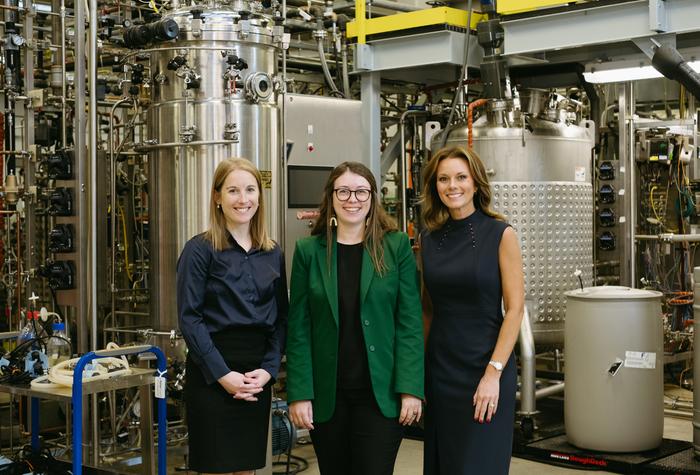URBANA, Ill. — President Joe Biden announced Monday that the Illinois Fermentation and Agriculture Biomanufacturing Hub (iFAB) is among 31 designated Regional Innovation and Technology Hubs (Tech Hubs) by the U.S. Economic Development Administration (EDA) — recognizing Central Illinois as a globally competitive center for innovation and job creation in biomanufacturing.
Led by the Integrated Bioprocessing Research Laboratory (IBRL) at the University of Illinois Urbana-Champaign, the iFAB consortium includes 30 partner organizations representing academic, industry, government, and nonprofit partners committed to catalyzing industry growth in Champaign, Piatt, and Macon counties.
“The iFAB designation leverages IBRL’s five years of operational success. Companies come here to prove their technologies, and our aim is for them to remain in the region and establish early manufacturing facilities to progress from ideation to commercialization,” said iFAB principal investigator Beth Conerty, the Associate Director of Business Development at IBRL, part of the College of Agricultural, Consumer and Environmental Sciences and The Grainger College of Engineering.
The EDA Tech Hubs program was authorized by the bipartisan CHIPS and Science Act of 2022 with the goal to boost economic growth, spur job creation, and ensure U.S. national security.
The precision fermentation industry is projected to reach $11.8 billion by 2028, with the potential to generate one million jobs by 2030. The EDA’s Tech Hub designation elevates the reputation and confidence needed to attract more funding, resources, companies, and talent in this space to Central Illinois.
Precision fermentation is a growing area of biomanufacturing that can turn local feedstocks, mainly corn and soybeans, into a variety of goods — including textiles, biofuels, food ingredients, polymers, pigments, and more domestically. This sustainable, scalable, and biological manufacturing process relies on microbes to convert sugars into high-value products.
“Our position as a regional leader in precision fermentation is solidified by this designation,” said iFAB partner Nicole Bateman, president of the Economic Development Corporation of Decatur & Macon County. “Receiving federal recognition unlocks opportunities for infrastructure development and business investment and attraction, which results in job creation. We have been partnering across the corridor informally for several years, and the momentum in the region will be enhanced by this formal designation.”
As a designated Tech Hub, iFAB has cleared the first phase of the Tech Hubs program and qualifies to apply for phase two funding of $45 million to $70 million. EDA anticipates that between five and 10 of the 31 Tech Hubs will receive phase two funding.
If successful, phase two funding would support several iFAB initiatives to expand the Central Illinois precision fermentation industry:
- Support capital projects to create more multi-use facilities and infrastructure to support growth-stage bioprocessing and fermentation companies; lab space is needed to scale high-growth ventures in the region.
- Expand workforce development training programs at Parkland College and Richland Community College in partnership with industry partners to provide relevant job skills.
- Broaden the biomanufacturing entrepreneurial ecosystem through efforts at University of Illinois Research Park and the Illinois AgTech Accelerator to fuel startups.
- Attract companies through the Economic Development Corporations (EDC) in Champaign County and Decatur & Macon County in partnership with the Illinois Department of Commerce and Economic Opportunity (DCEO) and Intersect Illinois.
“This historic announcement is a result of our regional and statewide collaboration and will enhance business attraction to our region, expanding our ever-growing AgTech footprint,” said iFAB partner Carly McCrory-McKay, executive director of the Champaign County EDC. “We’re thrilled about this Tech Hub designation for our communities and will work with our partners to ensure that the iFAB AgTech Corridor—made up of Champaign, Macon, and Piatt counties—becomes the global leader and innovation center in biomanufacturing. This is a game changer for innovation and economic growth, and we’re proud to say that iFAB is a Tech Hub.”
iFAB’s Tech Hub designation is a return on investment by the State of Illinois. “IBRL was a strategic experiment that has shown proof of concept,” Conerty said. “We have been overwhelmed by the response for equipment, infrastructure, and expertise. We are now bursting at the seams with a waitlist for equipment and processes. With more support, we could be doing so much more.”
The consortium’s industry partners include ADM and Boston Bioprocess, who both have operations at Research Park, as well as Primient and Clarkson Grain Company.
iFAB is one of two designated Tech Hubs in Illinois; the second is the Chicago-based The Bloch Tech Hub that focuses on quantum technologies. Both coalitions are part of Innovate Illinois, a strategic initiative led by Governor JB Pritzker to establish Tech Hubs in the state.
“As one of America’s leading research universities, the University of Illinois Urbana-Champaign solves problems and helps to power our nation’s economy,” said U. of I. Chancellor Robert E. Jones. “These TechHub designations in Illinois unite our strengths with our academic, industrial, community, and government partners to imagine a bright future for communities across the region.”








































